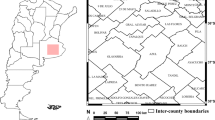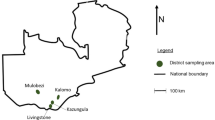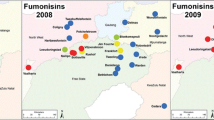Abstract
Natural mycoflora associated with fumonisins were analyzed in 150 samples of freshly harvested corn from Central-Southern, Central-Western and Northern regions of the State of Paraná, Brazil and correlated to climatic conditions. The corn samples were frequently contaminated with Fusarium sp.(98.7 to 100%) and Penicillium sp. (93 to 100%), when compared to Aspergillus sp. (not detected to 27.7%). The highest contamination with potentially mycotoxigenic fungi occurred in corn harvested in the Central-Western region, where total mould and yeast counts ranged from 5.5 × 103 to 5.2 × 106 CFU/g, with 98.7% contaminated byFusarium sp. and 93% by Penicillium sp. In this region F. moniliforme (F. verticillioides) was the predominant Fusariumsp., and was isolated in 85.9% of the samples. Aspergillus sp. was isolated from 27.7% samples. FB1 was detected in 100% of the samples (mean of 2.39 μg/g) and FB2 in 97.7% (mean of 1.09 μg/g). Fumonisins were also detected in all samples from Northern region, with mean of 4.56 μg/g (FB1) and 2.20 μg/g (FB2).Considering 1.0 μg/g as the threshold, 72% of the corn samples from the Central-West and 92% from the North were contaminated with concentrations above this value, in contrast to a 18.5% contamination rate from Central-Southern samples. Between corn planting to harvesting season, the average maximum temperature and relative humidity were 26 °C and 77.1%(Central-Southern), 27 °C and 69% (Northern)and 29.9 °C and 89.1% (Central-Western).Therefore, the higher fumonisins contamination of corn from Northern region when compared to the Central-South were due to the differences in rainfall levels (92.8 mm in Central-Southern, 202 mm in Northern) during the month preceding harvest.
Similar content being viewed by others
References
Melo Filho GA, Richetti A. Aspectos socioeconômicos da cultura do milho. In: Milho-Informações técnicas. Dourados: EMBRAPA (EMBRAPA - CPAO), Circular Técnica, 1997; 5: 13–38.
Miller JD. Global significance of mycotoxins and phycotoxins. In: IX International IUPAC Symposium on Mycotoxins and Phycotoxins, Rome, Instituto Superiore di Sanitá, 1996: 31.
Gelderblom WCA, Jaskiewicz K, Marasas WFO, Thiel PG, Horak RM, Vleggaar R, Kriek, NPJ. Fumonisins - novel mycotoxins with cancer-promoting activity produced by Fusarium moniliforme. Appl Environ Microbiol 1988; 54: 1806–1811.
Sydenham EW, Shephard GS, Thiel PG. Liquid chromatographic determination of fumonisins B1, B2, and B3 in foods and feeds. J AOAC Int 1992; 75: 313–318.
Scott PM. Fumonisins. Int J Food Microbiol 1993; 18: 257–270.
Weibking TS, Ledoux DR, Bermudez AJ, Turk JR, Rottinghaus GE, Wanf E, Merrill, AH. Effects of feeding Fusarium moniliforme culture material, containing known levels of fumonisin B1 on the young broiler chick. Poultry Science 1993; 72: 456–466.
Weibking TS, Ledoux DR, Bermudez AJ, Rottinghaus GE. Individual and combined effects of feeding Fusarium moniliforme culture material, containing known levels of fumonisin B1 and aflatoxin B1 in the young turkey. Poultry Science 1994; 73: 1517–1525.
Nagaraj RY, Wu WD, Vesonder RJ. Toxicity of corn culture material of Fusarium proliferatum M-7176 and nutritional intervention in chicks. Poultry Science 1994; 73: 617–626.
Gelderblom WCA, Sample E, Marasas WFO. The cancer initiating potential of the fumonisins B mycotoxins. Carcinogenesis 1992; 13: 433–437.
Thiel PG, Marasas WFO, Sydenham EW, Shephard GS, Gelderblom WCA. The implications of naturally occurring levels of fumonisins in corn for human and animal health. Mycopathologia 1992; 117: 3–9.
Jackson LS, Devries JW, Bullerman LB, eds. Fumonisins in Food. New York: Plenum Press, 1996.
Ueno Y, Iijima K, Wang S-D, Sugiura Y, Sekijima M, Tanaka T, Chen C, Yu S-Z. Fumonisins as a possible contributory risk factor for primary liver cancer: A 3-year study of corn harvested in Haimen, China, by HPLC and ELISA. Fd Chem Toxicol 1997; 35: 1143–1150.
Munkvold GP, Desjardins AE. Fumonisins in maize. Can we reduce their occurrence? Plant Disease 1997; 81: 556–565.
Visconti A, Boenke A. Improvement of the determination of fumonisins (FB1 and FB2) in maize and maize-based feeds. European Comission BCR Information - Chemical Analysis. Belgium, 1995.
Anon. Acompanhamento da Situação Agropecuária do Paraná. Governo do Estado do Paraná. Secretaria de Estado da Agricultura e do Abastecimento 1993; 19: 1–92. (in Portuguese)
Anon. Acompanhamento da Situação Agropecuária do Paraná. Governo do Estado do Paraná. Secretaria de Estado da Agricultura e do Abastecimento 1998; 24: 75–76. (in Portuguese)
Hirooka EY, Yamaguchi MM, Aoyama S, Sugiura Y, Ueno Y. The natural occurrence of fumonisins in Brazilian corn kernels. Food Addit Contam 1996; 13: 173–183.
Brasil. Portaria n°. 845 de 8 de novembro de 1976. Diário Oficial da República Federativa do Brasil. Brasília, 30 de novembro de 1976. (in Portuguese)
Nelson PE, Tousson TA, Marasas WFO. Fusarium species - An illustrated manual for identification. Pennsylvania: Pennsylvania State University Press, 1983.
Singh K, Frisvad JC, Thrane U, Mathur SB. An illustrated manual on identification of some seed-borne Aspergilli, Fusaria, Penicillia and their mycotoxins. Hellerup/Denmark: Danish Government, 1991.
Samson RA, Hoeskstra ES, Frisvad JC, Filtenborg O. Introduction to food-borne fungi. The Netherlands: Centraalbureau voor Schimmelcultures, 1995 (4.ed.).
I.S.T.A. (International Seed Testing Association). Seed Health Testing. Seed Sci. Technol. 1976; 4: 3–49.
Shephard GS, Sydenham EW, Thiel PG, Gelderblom WCA. Quantitative determination of fumonisins B1 and B2 by highperformance liquid chromatography with fluorescence detection. J Liq Chromatogr 1990; 13: 2077–2087.
Ueno Y, Aoyama S, Sugiura Y, Wang DS, Lee US, Hirooka E Y, Hara S, Karki T, Chen G, Yu SZ. A limited survey of fumonisins in corn and corn-based products in Asian countries. Mycotoxin Res 1993; 9: 27–34.
González HHL, Resnik SL, Boca RT, Marasas WFO. Mycoflora of Argentinian corn harvested in the main production area in 1990. Mycopathologia 1995; 130: 29–36.
Julian AM, Wareing PW, Phillips SI, Medlock VFP, Macdonald MV, Del Rio LE. Fungal contamination and selected mycotoxins in pre-and post-harvest maize in Honduras. Mycopathologia 1995; 129: 5–16.
Pozzi CR, Corrêa B, Gambale W, Paula CR, Chacon-Reche NO, Meirelles MCA. Postharvest and stored corn in Brazil: mycoflora interaction, abiotic factors and mycotoxin occurrence. Food Addit Contam 1995; 12: 313–319.
Orsi RB, Corrêa B, Pozzi CR, Schammass EA, Nogueira JR, Dias SMC, Malozzi MAB. Mycoflora and occurrence of fumonisins in freshly harvested and stored hybrid maize. J Stored Prod Res 1999; 00: 1–13 (in press).
Bacon CW, Williamson JW. Interactions of Fusarium moniliforme, its metabolites and bacteria with corn. Mycopathologia 1992; 117: 65–71.
Marasas WFO, Kriek NPJ, Wiggins V, Steyn PS, Towers DK, Hastie J. Incidence, geographical distribution and toxigenicity of Fusarium species in South African corn. Phytopathology 1979; 69: 1181–1185.
Nelson PE, Desjardins AE, Plattner RD. Fumonisins, mycotoxins produced by Fusarium species: biology, chemistry and significance. Ann Rev Phytopathol 1993; 31: 233–252.
Visconti A, Doko MB. Survey of fumonisin production by Fusarium isolated from cereals in Europe. J AOAC Int 1994; 77: 546–550.
Yoshizawa T, Yamashita A, Luo Y. Fumonisin occurrence in corn from high-and low-risk areas for human esophageal cancer in China. Appl Environ Microbiol 1994; 60: 1626–1629.
Ross PF, Rice LG, Osweiler GD, Nelson PE, Richard JL, Wilson TM. A review and update of animal toxicoses associated with fumonisin-contaminated feeds and production of fumonisins by Fusarium isolates. Mycopathologia 1992; 117: 109–114.
Ross PF, Rice, LG, Plattner RD, Osweiler GD, Wilson TM, Owens DL, Nelson HA, Richard JL. Concentrations of fumonisin B1in feeds associated with animal health problems. Mycopathologia 1991; 114: 129–135.
Viquez OM, Castell-Perez ME, Shelby RA. Occurrence of fumonisin B1 in maize grown in Costa Rica. J Agric Food Chem 1996; 44: 2789–2791.
Visconti A. Fumonisins in maize genotypes grown in various geographic areas. In: Jackson LS, De Vries JW, Bullerman LB, eds. Fumonisins in food. New York: Plenum Press, 1996: 193–204.
Kedera CJ, Plattner RD, Desjardins, AE. Incidence of Fusarium spp. and levels of fumonisin B1 in maize inWestern Kenya. Appl Environ Microbiol 1999; 65: 41–44.
Stockenström S, Sydenham EW, Shephard GS. Fumonisin B1, B2 and B3 content of commercial unprocessed maize imported into South Africa from Argentina and the USA during 1992. Food Addit Contam 1998; 15: 676–680.
Bullerman LB. Occurrence of Fusarium and fumonisins on food grains and in foods. In: Jackson LS, De Vries JW, Bullerman LB, eds. Fumonisins in food. New York: Plenum Press, 1996: 27–38.
Author information
Authors and Affiliations
Rights and permissions
About this article
Cite this article
Ono, E.Y.S., Sugiura, Y., Homechin, M. et al. Effect of climatic conditions on natural mycoflora and fumonisins in freshly harvested corn of the State of Paraná, Brazil. Mycopathologia 147, 139–148 (1999). https://doi.org/10.1023/A:1007171701245
Issue Date:
DOI: https://doi.org/10.1023/A:1007171701245




